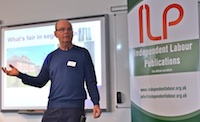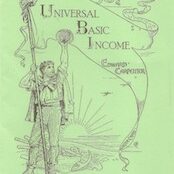The government does not intend to solve our housing crisis, says Dr QUINTIN BRADLEY. Instead, it is using housing as a policy weapon against the beliefs and attitudes that sustain the welfare state.
Much of the attack on the welfare state has been about constructing a new common sense view in which the private market is regarded as the only fair system for distributing goods and rewards. In this view, it is seen as unfair when people don’t pay their way – meaning, when they don’t pay market prices they are seen as getting something for nothing.
 This common sense says that housing benefit is unfair because it allows some people to live in expensive neighbourhoods without paying for the privilege. The message is, if you can’t afford to live in nice places, you shouldn’t live there – it’s as simple as that.
This common sense says that housing benefit is unfair because it allows some people to live in expensive neighbourhoods without paying for the privilege. The message is, if you can’t afford to live in nice places, you shouldn’t live there – it’s as simple as that.
As a result housing benefit has been cut back and capped, the fairness of the housing market has been reasserted, with house prices the fair means for keeping the nicest and most expensive areas – and those parts of the country where homes are most in demand – out of reach of anyone who is not already very well-off.
The Housing and Planning Bill makes the message of market fairness even more explicit. It introduces big subsidies for people buying high-priced housing while, at the same time, getting rid of affordable homes in high-priced areas.
The Bill defines home ownership as affordable if it costs £450,000 in London, or £250,000 elsewhere. It redirects all existing subsidies towards building Starter Homes and cuts the supply of affordable non-profit housing. To afford these ‘affordable’ prices, first time buyers will need to be earning around £100,000 a year. They will benefit from a 20 per cent discount and when they sell their house in five years’ time they are likely to make a cash profit of £141,000, paid for by the taxpayer.
To pay for this cash transfer to the already well-off, the Housing Bill forces local authorities to sell their council housing in high-value areas when it becomes vacant. This will mean that high rent cities in the north of England, such as York and Harrogate, will lose a majority of their affordable housing, while in London boroughs council housing will be almost wiped out. It is anticipated that around 350,000 social rented affordable homes will be lost.
A new right to buy for housing association tenants comes at the very worst time, when hardly any new affordable homes are being built, and it is unlikely that those sold will be replaced. Again, massive tax-payer funded discounts are available for people to buy their homes and, once bought, those homes stop being affordable and can be sold on the open market or let out after five years at high private rents.
Rents for local authority and housing association homes are set by the government, so you’d be forgiven for thinking that they were already fair, and that cuts in housing allowances, such as the bedroom tax, were unnecessary. Late in 2015 the government made a surprise U-turn in policy and reversed a 10-year rent programme to impose a 1% cut in income for social housing providers, year-on-year. This has forced councils and many housing associations to stop building affordable homes or to drastically cut back, and make hundreds of staff redundant.
As well as reducing the amount of affordable rented homes, the Bill also sets out to make conditions worse for council tenants by tearing up their security of tenure and bringing in a personal means tests linked to higher rents. At the same time, the government is making even bigger cuts in housing benefit and these will affect social housing tenants, especially people living in sheltered housing, supported housing, hostels and refuges. The effect is to drive people into the private rented sector and to reduce the quality of non-profit housing so that it is as bad and as expensive as market rented housing.
Basic human need
The message is that there is only one common sense, the common sense of the market. The trouble with this idea is that the housing market does not operate according to any of the rules of the free market. Supply and demand do not function in housing. For a start, housing is a basic human need and everyone needs a home. But housing also operates as an investment market, with strong demand for second homes, and a thriving buy to let market, and buy to leave market, providing sustained interest growth for global investment finance.
 Beneath all these different housing markets, is the scarcest commodity of all: land. Land is not a real commodity because it’s a finite asset. We don’t make it anymore, as Mark Twain once joked. Its use is rightly regulated by planning law, and that makes it all the more expensive and highly prized. Land prices are fuelling the price bubble in housing, and also contributing to the shortage of new homes built, because more money can be made trading land with planning permission, than actually building on it.
Beneath all these different housing markets, is the scarcest commodity of all: land. Land is not a real commodity because it’s a finite asset. We don’t make it anymore, as Mark Twain once joked. Its use is rightly regulated by planning law, and that makes it all the more expensive and highly prized. Land prices are fuelling the price bubble in housing, and also contributing to the shortage of new homes built, because more money can be made trading land with planning permission, than actually building on it.
So it is misleading to pretend that housing is a free market and that supply and demand will balance out if left to their own devices. And, anyway, government is continuing to intervene in the housing market by inflating demand and supply. Although buy to let has lost some of its tax discounts, market housing is supported by substantial tax incentives and the Housing and Planning Bill will provide additional subsidies to people who are already benefiting from the credit guarantees and deposit loans of Help to Buy.
In total £43 billion in public money is going to subsidise market housing, while investment in affordable homes has fallen to its lowest since the Second World War. Public subsidies for home ownership are not aimed at bringing house prices down. Instead, the government is trying to pull off the clever balancing trick of pushing prices higher while helping more people afford them. House price inflation is the lever of the UK economy; high house prices mean home owners feel like spending or taking out extra credit and that drives economic growth. The last thing the government wants is to bring house prices down.
The result is an incredibly polarised housing market dominated by affluent retirees who have fully paid off their mortgages and now outnumber first time buyers. Home ownership has declined from 71% in 2003 to 65.2% today which can be no surprise when the average house price is now 10 times the average wage.
Rising house prices mean even higher private rents and the private rented sector is the ultimate beneficiary of government housing policy, expanding and bloating as it engulfs all those deprived of an affordable home. One third of private rented housing is unfit for human habitation but that can’t stop this supersized sector, which has swelled by 57% in the last five years.
The encouragement of buy to let mortgages has driven this expansion giving strong returns on housing investment, with an open door to international investment capital. The outcome is that most private landlords own only one or two rental properties and depend on the services of rental agencies whose interests are served by increasing rents every six months, and racking up charges for credit checks and other unaccountable administrative charges.
One third of tenants in the private rented sector are forced to move every six months as their tenancy is ended. The profile of renters is no longer young singles, but families with children, and the end of a six month tenancy is now the greatest cause of homelessness, with the number of evictions increasing by 53% over the last five years, to the equivalent of more than 170 a day.
Looking-glass world
There is a direct connection between the rise in house prices, the resurgence of private renting and the loss of public and not-for-profit affordable housing. Up until 1980, around one third of UK households lived in council housing, and until the 1970s this country was building about 100,000 council homes each year, on top of those built by the private sector.
A buoyant council housing sector kept market house prices low and avoided boom and bust. Council housing out-performed private renting, because it was far more affordable and provided hugely better standards. Although the supply was rationed, and often the most vulnerable got the worst of it, council housing provided generations of families with a secure start in life, and gave them hope, aspiration and belief in progress.
Public and not-for-profit housing has proved itself an efficient and effective economic model across Europe, enabling rents to be kept low, while bringing in surplus that can be reinvested in improved homes. Its economic efficiency has made it a target for attack by private corporate interests, supported by governments, who see a healthy public housing sector as a threat to private profit.
Public investment in building affordable housing – managed by public or not-for-profit landlords – is the most cost effective way of helping people find a home. An initial public subsidy means the house can be let at rents that are truly affordable to generation after generation. As more affordable homes are built, rents can be pooled allowing new homes to be subsidised by those whose costs have already been paid off. For every pound invested in affordable housing, another three pounds are brought back into the economy.
Affordable housing is a public good – a collective investment for everyone – for the many, not just the few. The government has converted public good into private gain. It is giving cash discounts on private housing to those already well-off while doing its best to rob future generations of their affordable homes. It justifies this mass sell-off of public goods by telling us it is fair. We must all buy our homes. At the same time, it is right and fair that homes are unaffordable.
In this looking-glass world, there is no sense, and no logic to the economic argument. Irrational opposition to any sense of public responsibility or collective insurance is sustained by a morbid fear of free-riding and propagated by the horror stories of poverty porn. This dog-fight society is fuelled by competition for public goods to such a pitch that we now think it’s better to get rid of all our affordable homes, and it’s better that nobody can have one than they should go to someone undeserving.
The battle for affordable homes, and for human wellbeing, can be fought and won on economic grounds, but it is really a battle about fairness, about how we encourage a society of care and hope. These are messages that still have the power to move and to convince.
I look back on council housing as a demonstration of faith in future generations. It was an investment in people as well as in bricks and mortar. We can build a new message of fairness around the demand for a mass programme of affordable house building. We can draw on the best examples of affordable house building from across Europe, acknowledging the mistakes made in the past while building on the future.
We can plan for more co-operative housing, public and not-for-profit housing, run democratically, drawing on the example of Denmark, but better, built for everyone. We can make an investment in public goods, as in Sweden, but better, financed by a range of options, tax breaks and land transfers. And we can create a level playing field of housing subsidy, as in Germany, only better.
We need affordable housing that is planned by neighbourhoods, to generous space standards, with the best energy efficiency, designed for conservation and sustainability – an economically viable model that generates surplus to pay for itself over the lifetimes of its homes.
This is a vision where fairness lies, not in the market, but in everyone having a safe and secure place to live, where everyone has a good start in life. Where fairness means believing that we really are all in this together, that we all want to feel at home in the world.
—
Dr Quintin Bradley is a senior lecturer in planning and housing at Leeds Beckett University.
This article is based on his presentation to the ILP’s Unbalanced Britain conference on the Housing Crisis held in Leeds on 5 March.
You can read a report of the conference here.
Articles from the other two speakers at the seminar are also available here:
• ‘The Housing Crisis and the Struggle for Affordable Homes’, by Ellen Robottom of Hand off our Homes.
• ‘Rethinking Housing’, by Simon Jose, is here.
Click here to download the ILP’s leaflet about the event, Unbalanced Britain: Housing in Crisis.
Click here to read about previous meetings in the ILP’s Unbalanced Britain series.



31 March 2016
A very good piece.
. Build more good quality social homes and genuinely affordable homes to buy plus on the lines of Parker- Morris standards.
. Bring in rent controls and use savings from £14b Housing Benefit Bill to refurbish empty homes to rent and buy; these are already on site so would save some brownfield/green belt plus could be done by LAs, Housing Associations, Housing Co-operatives.
. Bring back taxes on private landlords with multiple properties (cut by the Tories/Lib Dems).
. Statutory right to tenants consultation in public and private rented sectors and better security of tenure like the European model.
. Radically redesign run-down social housing estates in consultation with residents to green them up including park areas and to provide community amenities.
. Look at owner-occupation so we get back to people actually wanting a lovely home to live in rather than seeing housing as a financial investment; we could look at flexible mortgages (buy 50% rent 50%) so can revert to renting if face hardship or you buy half and get the rest on a 120 year lease (like some housing in conservation areas).
We need decent homes for all in all tenures!
31 March 2016
[…] of the talk he gave at the Summit, and the slides he presented at the conference are here too. article slide show Spread the word!:TwitterFacebookLinkedInGoogleEmailPrintLike this:Like […]